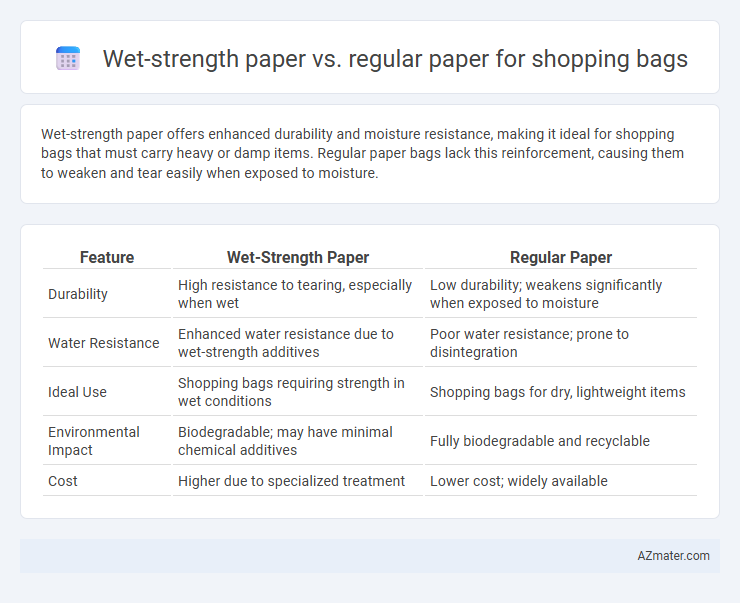Wet-strength paper offers enhanced durability and moisture resistance, making it ideal for shopping bags that must carry heavy or damp items. Regular paper bags lack this reinforcement, causing them to weaken and tear easily when exposed to moisture.
Table of Comparison
| Feature | Wet-Strength Paper | Regular Paper |
|---|---|---|
| Durability | High resistance to tearing, especially when wet | Low durability; weakens significantly when exposed to moisture |
| Water Resistance | Enhanced water resistance due to wet-strength additives | Poor water resistance; prone to disintegration |
| Ideal Use | Shopping bags requiring strength in wet conditions | Shopping bags for dry, lightweight items |
| Environmental Impact | Biodegradable; may have minimal chemical additives | Fully biodegradable and recyclable |
| Cost | Higher due to specialized treatment | Lower cost; widely available |
Introduction to Paper Types for Shopping Bags
Wet-strength paper for shopping bags incorporates synthetic resins that enhance durability and resistance to moisture, making it ideal for carrying wet or heavy items. Regular paper lacks these additives, resulting in lower strength and susceptibility to tearing when exposed to water or heavy loads. Choosing wet-strength paper increases bag longevity and reliability, especially in environments where moisture exposure is frequent.
What is Wet-Strength Paper?
Wet-strength paper is specially treated to maintain its durability and structural integrity when exposed to moisture, making it ideal for shopping bags that may encounter wet conditions. Unlike regular paper, which weakens and tears easily when wet, wet-strength paper incorporates chemical additives during manufacturing that reinforce fiber bonds. This enhanced resilience ensures shopping bags can reliably carry heavier items without disintegration, providing a more sustainable alternative to plastic bags.
Understanding Regular Paper Properties
Regular paper used for shopping bags typically exhibits moderate tensile strength and limited water resistance, making it prone to tearing or deforming when exposed to moisture. Its cellulose fibers, bonded mainly through hydrogen bonds, do not provide sufficient durability under wet conditions, leading to reduced load-bearing capacity. Understanding these inherent properties highlights why regular paper is less suitable for heavy or damp environments compared to wet-strength paper options.
Key Differences: Wet-Strength vs Regular Paper
Wet-strength paper contains additives like resin to enhance durability and maintain strength when exposed to moisture, making it ideal for shopping bags handling wet or heavy items. Regular paper lacks these water-resistant properties and tends to weaken or tear easily when wet, limiting its use in adverse conditions. Choosing wet-strength paper for shopping bags ensures better performance and reliability in carrying groceries or damp products.
Durability in Wet Conditions
Wet-strength paper used for shopping bags incorporates resin additives that significantly enhance its fiber bonding, providing superior durability in wet conditions compared to regular paper. Regular paper tends to weaken and tear easily when exposed to moisture due to the lack of these reinforcing agents. This enhanced water resistance makes wet-strength paper an ideal choice for shopping bags that need to maintain structural integrity during rainy weather or when carrying moist or damp items.
Environmental Impact and Sustainability
Wet-strength paper used for shopping bags significantly enhances durability and water resistance, reducing the need for plastic alternatives and minimizing environmental pollution. Regular paper, while biodegradable, lacks the robustness to handle moisture, resulting in increased waste due to bag damage and shorter lifecycle. Choosing wet-strength paper supports sustainability by extending bag usability, lowering resource consumption, and promoting eco-friendly packaging solutions.
Cost Comparison: Wet-Strength vs Regular Paper
Wet-strength paper for shopping bags typically costs 20-40% more than regular paper due to its enhanced durability and resistance to moisture. The higher price stems from specialized resin or chemical treatments that improve wet strength, increasing production expenses. Although more expensive upfront, wet-strength paper reduces the risk of bag damage from wet conditions, potentially lowering replacement and product loss costs.
Printing and Customization Capabilities
Wet-strength paper offers superior durability and resistance to moisture, making it ideal for shopping bags exposed to wet conditions, while maintaining excellent print quality for vibrant and sharp graphics. Regular paper, though more cost-effective, tends to absorb ink differently, often resulting in less precise and less durable printing, which limits intricate customization options. Enhanced coating technologies for wet-strength papers allow for a wider range of printing techniques, including offset, flexographic, and digital printing, supporting high-resolution logos and detailed designs on shopping bags.
Ideal Applications for Each Paper Type
Wet-strength paper is ideal for shopping bags designed to carry heavy or moisture-prone items, such as groceries, frozen foods, or liquids, due to its enhanced resistance to tearing and water damage. Regular paper bags suit lightweight and dry items like clothing, bakery goods, or gift packaging where durability against moisture is less critical. Choosing the appropriate paper type improves bag performance and customer satisfaction based on specific retail needs.
Choosing the Best Paper for Shopping Bags
Wet-strength paper offers superior durability and resistance to moisture compared to regular paper, making it ideal for shopping bags that need to carry heavy or wet items without tearing. Regular paper is more economical but lacks the water resistance and strength required for long-lasting bags, often resulting in damage during use. Choosing wet-strength paper ensures reliable performance and enhances customer satisfaction by providing sturdy, moisture-resistant shopping bags.

Infographic: Wet-strength paper vs Regular paper for Shopping bag
 azmater.com
azmater.com